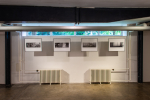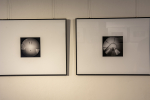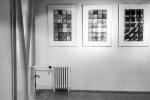30. 6. 2020 – 30. 8. 2020
At a time when contemporary digital cameras have reached truly breathtaking levels of quality, there is an increasing trend among photographers to return to the medium’s roots by working with techniques that do not stun us by their visual quality but captivate us by their rawness and imperfection. And that is not all. Many photographers aim not only for visual effect (which can be achieved just as well on a computer), but also feel the need for physical contact with the act of creating a photograph. They seek an experience that cannot be replaced by anything else. Courses of historical photographic techniques are overflowing as photographers seek to master 19th-century techniques such as the wet collodion process, cyanotype printing, salt prints, and more. This trend can be seen even among established artists, who – enamored by handcrafted work – wildly create noble prints of their entire archives. It should be added that very few have managed to apply their newly acquired skills in a truly creative manner, and that most outcomes are somewhat questionable in quality.
The Jihlava-based photographer Pavel Piňos is fascinated by the art of making photographs using a pinhole camera, meaning a camera without a lens. He has worked with pinhole cameras for years, but most importantly he is a regular participant in the photographic workshops at Villa Tugendhat where the experienced photographers Gabriela Kolčavová and Roman Franc teach this technique to the general public. As a result, the villa and its surroundings quite naturally have become one of Piňos’s main themes, if not a downright obsession. An amateur in the true sense of the word, he loves his “work” and has managed to infect his entire family with his enthusiasm. He is not concerned about the world of contemporary art, and so he has the luxury of assessing his photographs using words that (unfortunately) have become almost taboo for today’s professionals: “I don’t like this picture very much,” or “I still like this one.” Admittedly, being a point of reference for one’s own work is a somewhat precarious matter, but any pitfalls associated with such an approach can be offset by humility, sobriety, and openness. I believe that Pavel possesses these qualities, as evidenced by the fact that his exhibition Lensless is his first larger showing after roughly seven years of systematic work.
During this time, his archive has grown to include a large number of relatively diverse photographs in terms of composition and technique. He builds his own cameras, either from old “cannibalized” cameras or from a simple box. One example is his 28-hole camera obscura, which produces a very specific and visually attractive image. He also likes to use non-traditional film and paper.
Piňos often photographs Villa Tugendhat’s luxurious architecture a little like a voyeur. He captures not only places viewers regularly “visit” on tours, but also places his cameras around the site like mousetraps, letting the camera expose the image for several minutes in unusual positions and from fresh perspectives, waiting with baited breath for the outcome. This approach adds to the already quite unusual visual effects produced by the pinhole camera. The final image is deformed by perspective, by the imperfection of the pinhole technique, and by the angle of view all at once. A common thread running through all his work is his interest in technique and the mastery thereof.
Lensless presents a selection of Pavel Piňos’s previously unexhibited and unpublished work taken at Villa Tugendhat. The exhibition shows that, even in this universally known building, there is much to be discovered, and that one tour is hardly enough to take it all in. More time is needed to realize that even seemingly small things (this applies to photography as well as architecture) can possess a unique sense of magic.
Curator: Lukáš Bártl
Photographs: Pavel Piňos
Curator: Lukáš Bártl
Curators for Villa Tugendhat: Lucie Valdhansová, Barbora Benčíková, Ludmila Haasová
Graphic design: Ateliér Židlický
Proofreading: Kateřina Havelková Štěpančíková
Translation: Stephan von Pohl
A special collection of postcards created for this exhibition can be purchased in the bookshop of Villa Tugendhat.
The exhibition was prepared by the Tugendhat Study and Documentation Centre and has been realized with financial support from the Ministry of Culture of the Czech Republic. The exhibition is part of the Villa Tugendhat 90 celebrations held under the auspices of the Czech UNESCO Commission.









